GMC SIERRA 1500 2012 Owners Manual
Manufacturer: GMC, Model Year: 2012, Model line: SIERRA 1500, Model: GMC SIERRA 1500 2012Pages: 556, PDF Size: 7.88 MB
Page 361 of 556
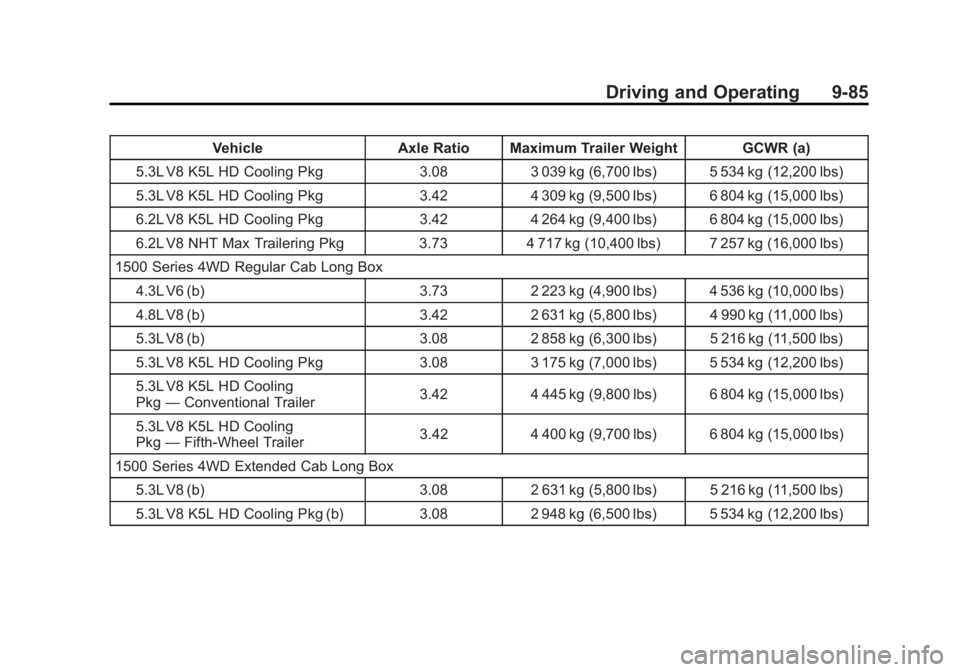
Black plate (85,1)GMC Sierra Owner Manual - 2012 - CRC - 11/15/11
Driving and Operating 9-85
VehicleAxle Ratio Maximum Trailer Weight GCWR (a)
5.3L V8 K5L HD Cooling Pkg 3.083 039 kg (6,700 lbs) 5 534 kg (12,200 lbs)
5.3L V8 K5L HD Cooling Pkg 3.424 309 kg (9,500 lbs) 6 804 kg (15,000 lbs)
6.2L V8 K5L HD Cooling Pkg 3.424 264 kg (9,400 lbs) 6 804 kg (15,000 lbs)
6.2L V8 NHT Max Trailering Pkg 3.734 717 kg (10,400 lbs) 7 257 kg (16,000 lbs)
1500 Series 4WD Regular Cab Long Box
4.3L V6 (b) 3.732 223 kg (4,900 lbs) 4 536 kg (10,000 lbs)
4.8L V8 (b) 3.422 631 kg (5,800 lbs) 4 990 kg (11,000 lbs)
5.3L V8 (b) 3.082 858 kg (6,300 lbs) 5 216 kg (11,500 lbs)
5.3L V8 K5L HD Cooling Pkg 3.083 175 kg (7,000 lbs) 5 534 kg (12,200 lbs)
5.3L V8 K5L HD Cooling
Pkg —Conventional Trailer 3.42
4 445 kg (9,800 lbs) 6 804 kg (15,000 lbs)
5.3L V8 K5L HD Cooling
Pkg —Fifth-Wheel Trailer 3.42
4 400 kg (9,700 lbs) 6 804 kg (15,000 lbs)
1500 Series 4WD Extended Cab Long Box 5.3L V8 (b) 3.082 631 kg (5,800 lbs) 5 216 kg (11,500 lbs)
5.3L V8 K5L HD Cooling Pkg (b) 3.082 948 kg (6,500 lbs) 5 534 kg (12,200 lbs)
Page 362 of 556
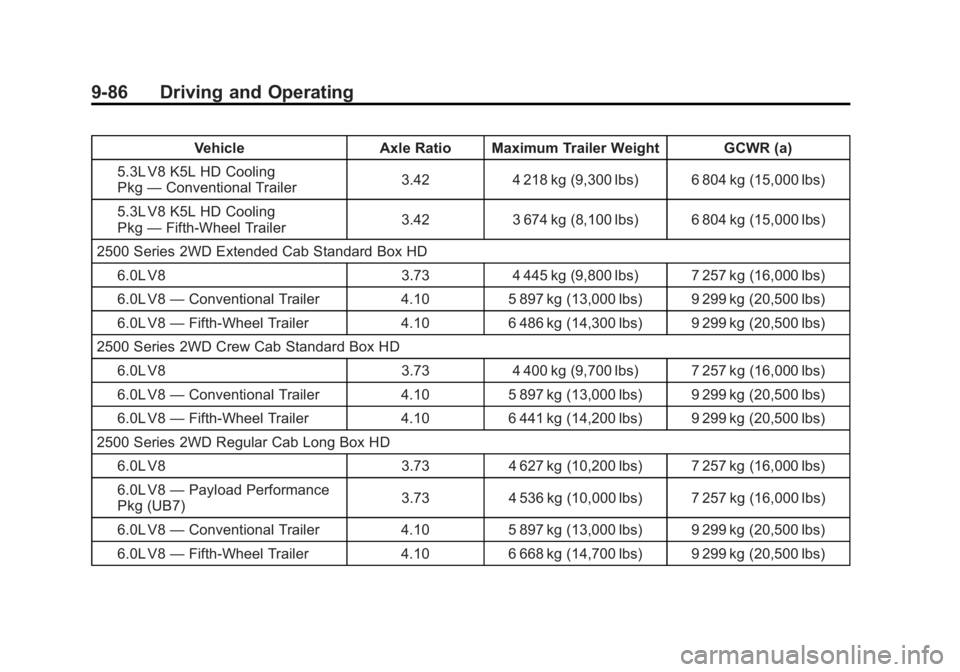
Black plate (86,1)GMC Sierra Owner Manual - 2012 - CRC - 11/15/11
9-86 Driving and Operating
VehicleAxle Ratio Maximum Trailer Weight GCWR (a)
5.3L V8 K5L HD Cooling
Pkg —Conventional Trailer 3.42
4 218 kg (9,300 lbs) 6 804 kg (15,000 lbs)
5.3L V8 K5L HD Cooling
Pkg —Fifth-Wheel Trailer 3.42
3 674 kg (8,100 lbs) 6 804 kg (15,000 lbs)
2500 Series 2WD Extended Cab Standard Box HD 6.0L V8 3.734 445 kg (9,800 lbs) 7 257 kg (16,000 lbs)
6.0L V8 —Conventional Trailer 4.105 897 kg (13,000 lbs) 9 299 kg (20,500 lbs)
6.0L V8 —Fifth-Wheel Trailer 4.106 486 kg (14,300 lbs) 9 299 kg (20,500 lbs)
2500 Series 2WD Crew Cab Standard Box HD
6.0L V8 3.734 400 kg (9,700 lbs) 7 257 kg (16,000 lbs)
6.0L V8 —Conventional Trailer 4.105 897 kg (13,000 lbs) 9 299 kg (20,500 lbs)
6.0L V8 —Fifth-Wheel Trailer 4.106 441 kg (14,200 lbs) 9 299 kg (20,500 lbs)
2500 Series 2WD Regular Cab Long Box HD
6.0L V8 3.734 627 kg (10,200 lbs) 7 257 kg (16,000 lbs)
6.0L V8 —Payload Performance
Pkg (UB7) 3.73
4 536 kg (10,000 lbs) 7 257 kg (16,000 lbs)
6.0L V8 —Conventional Trailer 4.105 897 kg (13,000 lbs) 9 299 kg (20,500 lbs)
6.0L V8 —Fifth-Wheel Trailer 4.106 668 kg (14,700 lbs) 9 299 kg (20,500 lbs)
Page 363 of 556
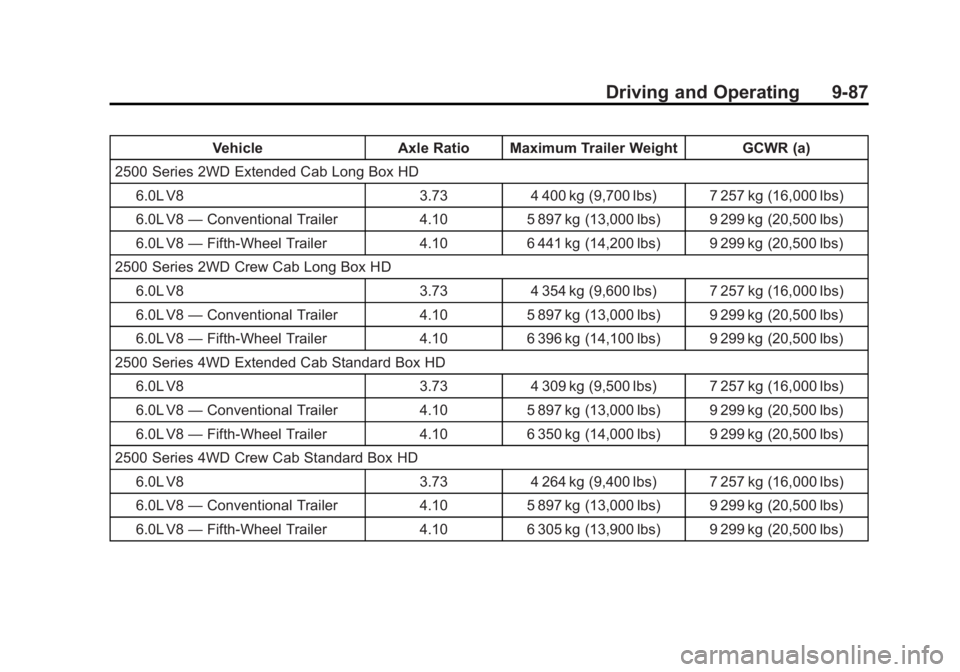
Black plate (87,1)GMC Sierra Owner Manual - 2012 - CRC - 11/15/11
Driving and Operating 9-87
VehicleAxle Ratio Maximum Trailer Weight GCWR (a)
2500 Series 2WD Extended Cab Long Box HD 6.0L V8 3.734 400 kg (9,700 lbs) 7 257 kg (16,000 lbs)
6.0L V8 —Conventional Trailer 4.105 897 kg (13,000 lbs) 9 299 kg (20,500 lbs)
6.0L V8 —Fifth-Wheel Trailer 4.106 441 kg (14,200 lbs) 9 299 kg (20,500 lbs)
2500 Series 2WD Crew Cab Long Box HD
6.0L V8 3.734 354 kg (9,600 lbs) 7 257 kg (16,000 lbs)
6.0L V8 —Conventional Trailer 4.105 897 kg (13,000 lbs) 9 299 kg (20,500 lbs)
6.0L V8 —Fifth-Wheel Trailer 4.106 396 kg (14,100 lbs) 9 299 kg (20,500 lbs)
2500 Series 4WD Extended Cab Standard Box HD
6.0L V8 3.734 309 kg (9,500 lbs) 7 257 kg (16,000 lbs)
6.0L V8 —Conventional Trailer 4.105 897 kg (13,000 lbs) 9 299 kg (20,500 lbs)
6.0L V8 —Fifth-Wheel Trailer 4.106 350 kg (14,000 lbs) 9 299 kg (20,500 lbs)
2500 Series 4WD Crew Cab Standard Box HD
6.0L V8 3.734 264 kg (9,400 lbs) 7 257 kg (16,000 lbs)
6.0L V8 —Conventional Trailer 4.105 897 kg (13,000 lbs) 9 299 kg (20,500 lbs)
6.0L V8 —Fifth-Wheel Trailer 4.106 305 kg (13,900 lbs) 9 299 kg (20,500 lbs)
Page 364 of 556
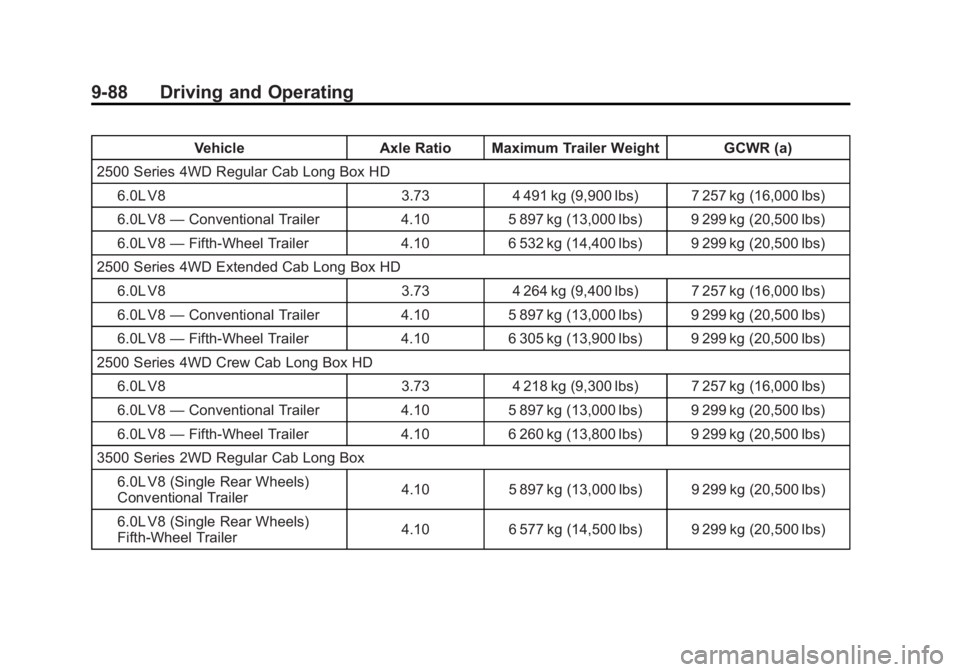
Black plate (88,1)GMC Sierra Owner Manual - 2012 - CRC - 11/15/11
9-88 Driving and Operating
VehicleAxle Ratio Maximum Trailer Weight GCWR (a)
2500 Series 4WD Regular Cab Long Box HD 6.0L V8 3.734 491 kg (9,900 lbs) 7 257 kg (16,000 lbs)
6.0L V8 —Conventional Trailer 4.105 897 kg (13,000 lbs) 9 299 kg (20,500 lbs)
6.0L V8 —Fifth-Wheel Trailer 4.106 532 kg (14,400 lbs) 9 299 kg (20,500 lbs)
2500 Series 4WD Extended Cab Long Box HD
6.0L V8 3.734 264 kg (9,400 lbs) 7 257 kg (16,000 lbs)
6.0L V8 —Conventional Trailer 4.105 897 kg (13,000 lbs) 9 299 kg (20,500 lbs)
6.0L V8 —Fifth-Wheel Trailer 4.106 305 kg (13,900 lbs) 9 299 kg (20,500 lbs)
2500 Series 4WD Crew Cab Long Box HD
6.0L V8 3.734 218 kg (9,300 lbs) 7 257 kg (16,000 lbs)
6.0L V8 —Conventional Trailer 4.105 897 kg (13,000 lbs) 9 299 kg (20,500 lbs)
6.0L V8 —Fifth-Wheel Trailer 4.106 260 kg (13,800 lbs) 9 299 kg (20,500 lbs)
3500 Series 2WD Regular Cab Long Box
6.0L V8 (Single Rear Wheels)
Conventional Trailer 4.10
5 897 kg (13,000 lbs) 9 299 kg (20,500 lbs)
6.0L V8 (Single Rear Wheels)
Fifth-Wheel Trailer 4.10
6 577 kg (14,500 lbs) 9 299 kg (20,500 lbs)
Page 365 of 556
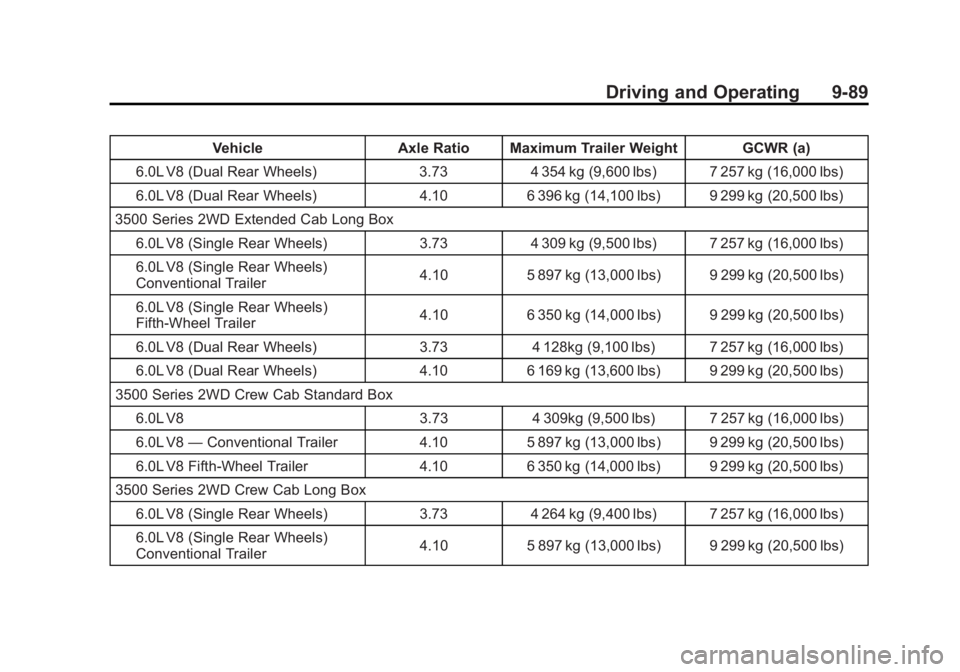
Black plate (89,1)GMC Sierra Owner Manual - 2012 - CRC - 11/15/11
Driving and Operating 9-89
VehicleAxle Ratio Maximum Trailer Weight GCWR (a)
6.0L V8 (Dual Rear Wheels) 3.734 354 kg (9,600 lbs) 7 257 kg (16,000 lbs)
6.0L V8 (Dual Rear Wheels) 4.106 396 kg (14,100 lbs) 9 299 kg (20,500 lbs)
3500 Series 2WD Extended Cab Long Box 6.0L V8 (Single Rear Wheels) 3.734 309 kg (9,500 lbs) 7 257 kg (16,000 lbs)
6.0L V8 (Single Rear Wheels)
Conventional Trailer 4.10
5 897 kg (13,000 lbs) 9 299 kg (20,500 lbs)
6.0L V8 (Single Rear Wheels)
Fifth-Wheel Trailer 4.10
6 350 kg (14,000 lbs) 9 299 kg (20,500 lbs)
6.0L V8 (Dual Rear Wheels) 3.734 128kg (9,100 lbs) 7 257 kg (16,000 lbs)
6.0L V8 (Dual Rear Wheels) 4.106 169 kg (13,600 lbs) 9 299 kg (20,500 lbs)
3500 Series 2WD Crew Cab Standard Box 6.0L V8 3.734 309kg (9,500 lbs) 7 257 kg (16,000 lbs)
6.0L V8 —Conventional Trailer 4.105 897 kg (13,000 lbs) 9 299 kg (20,500 lbs)
6.0L V8 Fifth-Wheel Trailer 4.106 350 kg (14,000 lbs) 9 299 kg (20,500 lbs)
3500 Series 2WD Crew Cab Long Box 6.0L V8 (Single Rear Wheels) 3.734 264 kg (9,400 lbs) 7 257 kg (16,000 lbs)
6.0L V8 (Single Rear Wheels)
Conventional Trailer 4.10
5 897 kg (13,000 lbs) 9 299 kg (20,500 lbs)
Page 366 of 556
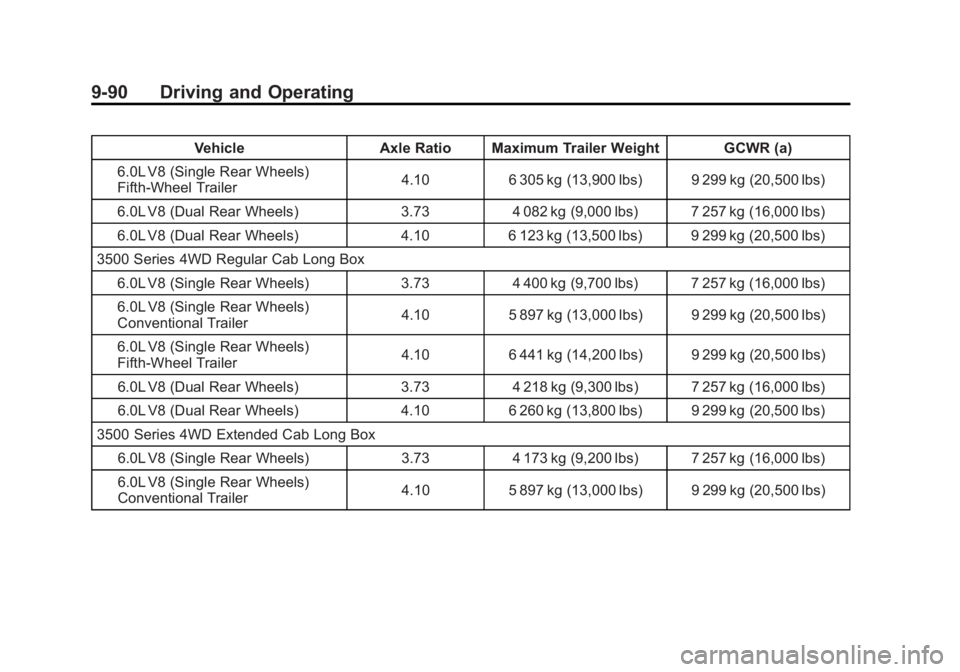
Black plate (90,1)GMC Sierra Owner Manual - 2012 - CRC - 11/15/11
9-90 Driving and Operating
VehicleAxle Ratio Maximum Trailer Weight GCWR (a)
6.0L V8 (Single Rear Wheels)
Fifth-Wheel Trailer 4.10
6 305 kg (13,900 lbs) 9 299 kg (20,500 lbs)
6.0L V8 (Dual Rear Wheels) 3.734 082 kg (9,000 lbs) 7 257 kg (16,000 lbs)
6.0L V8 (Dual Rear Wheels) 4.106 123 kg (13,500 lbs) 9 299 kg (20,500 lbs)
3500 Series 4WD Regular Cab Long Box
6.0L V8 (Single Rear Wheels) 3.734 400 kg (9,700 lbs) 7 257 kg (16,000 lbs)
6.0L V8 (Single Rear Wheels)
Conventional Trailer 4.10
5 897 kg (13,000 lbs) 9 299 kg (20,500 lbs)
6.0L V8 (Single Rear Wheels)
Fifth-Wheel Trailer 4.10
6 441 kg (14,200 lbs) 9 299 kg (20,500 lbs)
6.0L V8 (Dual Rear Wheels) 3.734 218 kg (9,300 lbs) 7 257 kg (16,000 lbs)
6.0L V8 (Dual Rear Wheels) 4.106 260 kg (13,800 lbs) 9 299 kg (20,500 lbs)
3500 Series 4WD Extended Cab Long Box
6.0L V8 (Single Rear Wheels) 3.734 173 kg (9,200 lbs) 7 257 kg (16,000 lbs)
6.0L V8 (Single Rear Wheels)
Conventional Trailer 4.10
5 897 kg (13,000 lbs) 9 299 kg (20,500 lbs)
Page 367 of 556
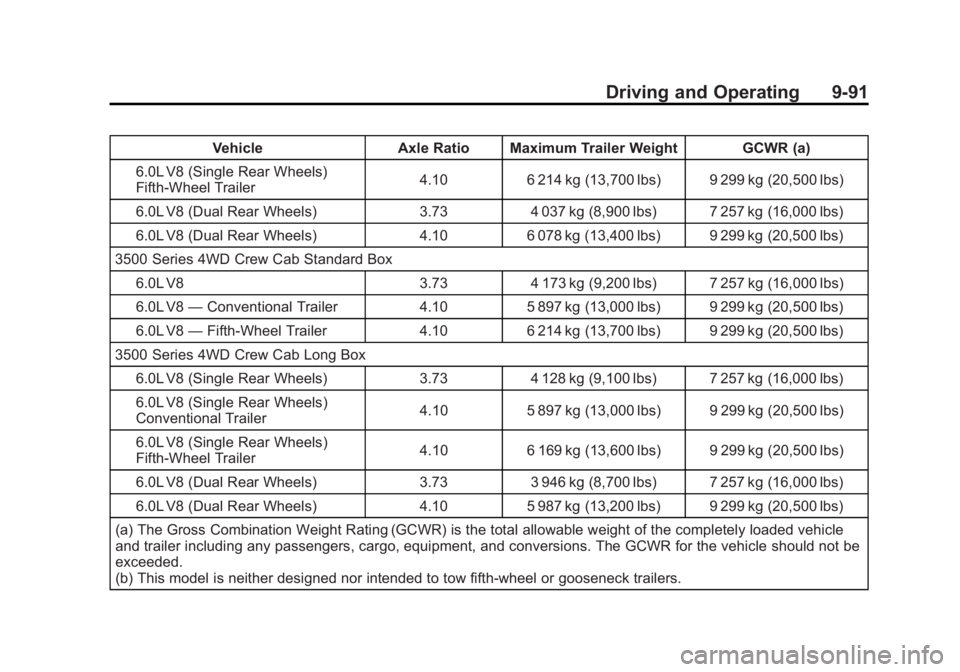
Black plate (91,1)GMC Sierra Owner Manual - 2012 - CRC - 11/15/11
Driving and Operating 9-91
VehicleAxle Ratio Maximum Trailer Weight GCWR (a)
6.0L V8 (Single Rear Wheels)
Fifth-Wheel Trailer 4.10
6 214 kg (13,700 lbs) 9 299 kg (20,500 lbs)
6.0L V8 (Dual Rear Wheels) 3.734 037 kg (8,900 lbs) 7 257 kg (16,000 lbs)
6.0L V8 (Dual Rear Wheels) 4.106 078 kg (13,400 lbs) 9 299 kg (20,500 lbs)
3500 Series 4WD Crew Cab Standard Box
6.0L V8 3.734 173 kg (9,200 lbs) 7 257 kg (16,000 lbs)
6.0L V8 —Conventional Trailer 4.105 897 kg (13,000 lbs) 9 299 kg (20,500 lbs)
6.0L V8 —Fifth-Wheel Trailer 4.106 214 kg (13,700 lbs) 9 299 kg (20,500 lbs)
3500 Series 4WD Crew Cab Long Box
6.0L V8 (Single Rear Wheels) 3.734 128 kg (9,100 lbs) 7 257 kg (16,000 lbs)
6.0L V8 (Single Rear Wheels)
Conventional Trailer 4.10
5 897 kg (13,000 lbs) 9 299 kg (20,500 lbs)
6.0L V8 (Single Rear Wheels)
Fifth-Wheel Trailer 4.10
6 169 kg (13,600 lbs) 9 299 kg (20,500 lbs)
6.0L V8 (Dual Rear Wheels) 3.733 946 kg (8,700 lbs) 7 257 kg (16,000 lbs)
6.0L V8 (Dual Rear Wheels) 4.105 987 kg (13,200 lbs) 9 299 kg (20,500 lbs)
(a) The Gross Combination Weight Rating (GCWR) is the total allowable weight of the completely loaded vehicle
and trailer including any passengers, cargo, equipment, and conversions. The GCWR for the vehicle should not be
exceeded.
(b) This model is neither designed nor intended to tow fifth-wheel or gooseneck trailers.
Page 368 of 556
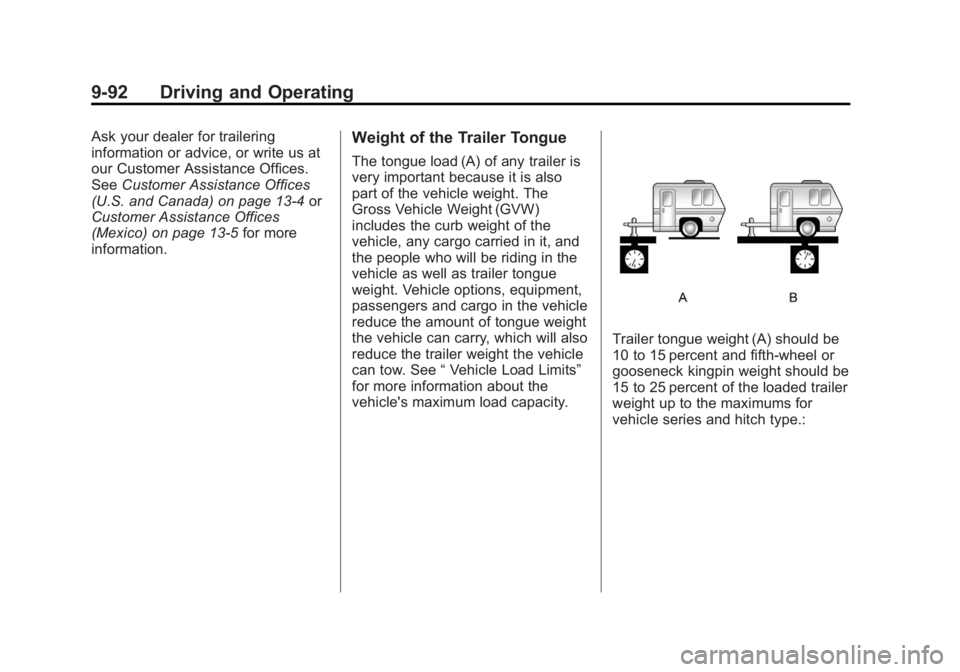
Black plate (92,1)GMC Sierra Owner Manual - 2012 - CRC - 11/15/11
9-92 Driving and Operating
Ask your dealer for trailering
information or advice, or write us at
our Customer Assistance Offices.
SeeCustomer Assistance Offices
(U.S. and Canada) on page 13‑4 or
Customer Assistance Offices
(Mexico) on page 13‑5 for more
information.Weight of the Trailer Tongue
The tongue load (A) of any trailer is
very important because it is also
part of the vehicle weight. The
Gross Vehicle Weight (GVW)
includes the curb weight of the
vehicle, any cargo carried in it, and
the people who will be riding in the
vehicle as well as trailer tongue
weight. Vehicle options, equipment,
passengers and cargo in the vehicle
reduce the amount of tongue weight
the vehicle can carry, which will also
reduce the trailer weight the vehicle
can tow. See “Vehicle Load Limits”
for more information about the
vehicle's maximum load capacity.
Trailer tongue weight (A) should be
10 to 15 percent and fifth-wheel or
gooseneck kingpin weight should be
15 to 25 percent of the loaded trailer
weight up to the maximums for
vehicle series and hitch type.:
Page 369 of 556
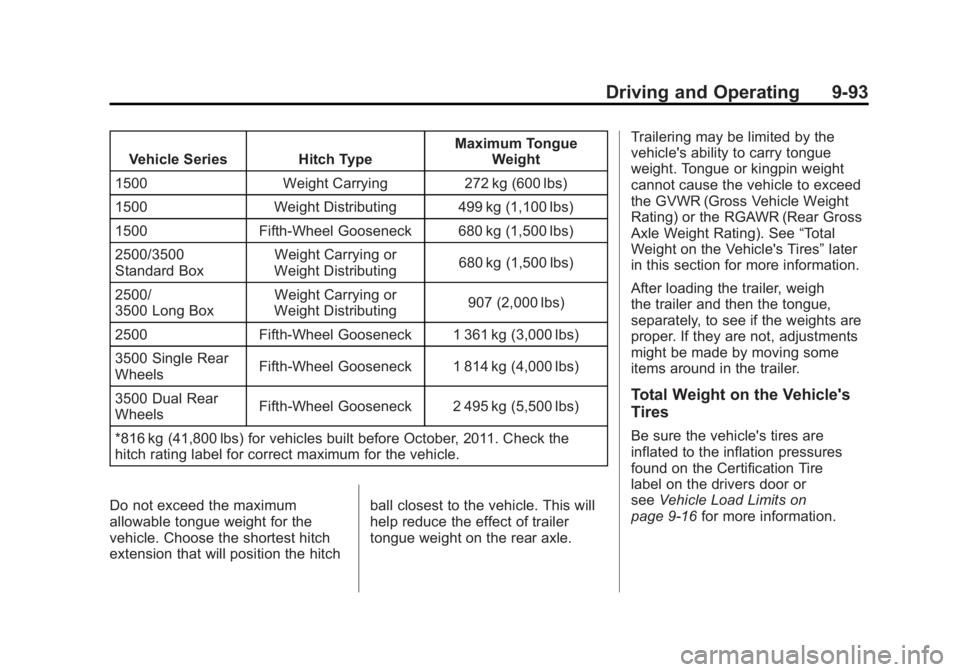
Black plate (93,1)GMC Sierra Owner Manual - 2012 - CRC - 11/15/11
Driving and Operating 9-93
Vehicle Series Hitch TypeMaximum Tongue
Weight
1500 Weight Carrying 272 kg (600 lbs)
1500 Weight Distributing 499 kg (1,100 lbs)
1500 Fifth-Wheel Gooseneck 680 kg (1,500 lbs)
2500/3500
Standard Box Weight Carrying or
Weight Distributing 680 kg (1,500 lbs)
2500/
3500 Long Box Weight Carrying or
Weight Distributing 907 (2,000 lbs)
2500 Fifth-Wheel Gooseneck 1 361 kg (3,000 lbs)
3500 Single Rear
Wheels Fifth-Wheel Gooseneck 1 814 kg (4,000 lbs)
3500 Dual Rear
Wheels Fifth-Wheel Gooseneck 2 495 kg (5,500 lbs)
*816 kg (41,800 lbs) for vehicles built before October, 2011. Check the
hitch rating label for correct maximum for the vehicle.
Do not exceed the maximum
allowable tongue weight for the
vehicle. Choose the shortest hitch
extension that will position the hitch ball closest to the vehicle. This will
help reduce the effect of trailer
tongue weight on the rear axle.Trailering may be limited by the
vehicle's ability to carry tongue
weight. Tongue or kingpin weight
cannot cause the vehicle to exceed
the GVWR (Gross Vehicle Weight
Rating) or the RGAWR (Rear Gross
Axle Weight Rating). See
“Total
Weight on the Vehicle's Tires” later
in this section for more information.
After loading the trailer, weigh
the trailer and then the tongue,
separately, to see if the weights are
proper. If they are not, adjustments
might be made by moving some
items around in the trailer.
Total Weight on the Vehicle's
Tires
Be sure the vehicle's tires are
inflated to the inflation pressures
found on the Certification Tire
label on the drivers door or
see Vehicle Load Limits on
page 9‑16 for more information.
Page 370 of 556
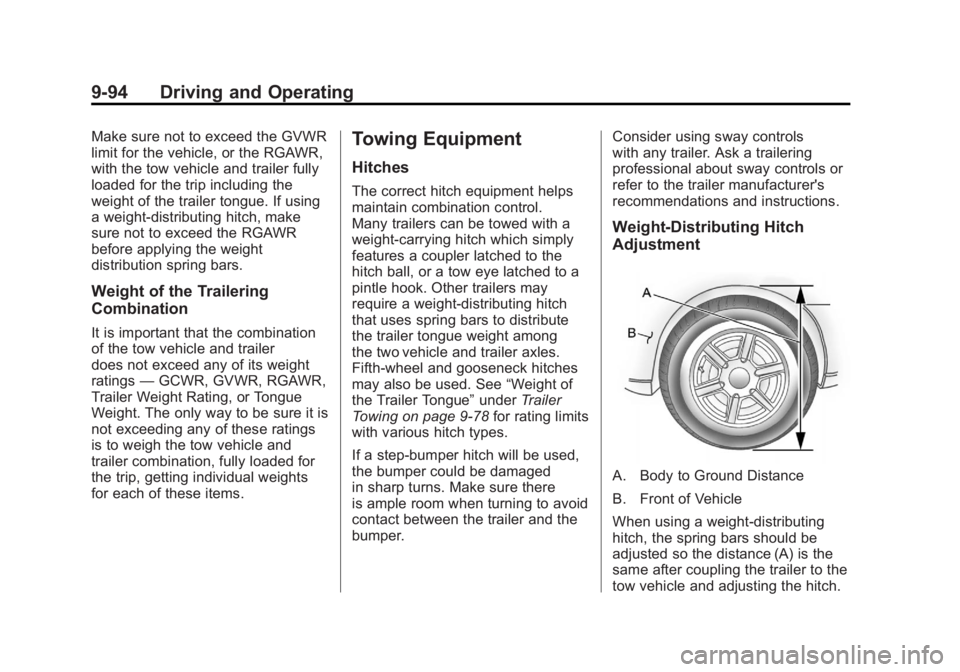
Black plate (94,1)GMC Sierra Owner Manual - 2012 - CRC - 11/15/11
9-94 Driving and Operating
Make sure not to exceed the GVWR
limit for the vehicle, or the RGAWR,
with the tow vehicle and trailer fully
loaded for the trip including the
weight of the trailer tongue. If using
a weight-distributing hitch, make
sure not to exceed the RGAWR
before applying the weight
distribution spring bars.
Weight of the Trailering
Combination
It is important that the combination
of the tow vehicle and trailer
does not exceed any of its weight
ratings—GCWR, GVWR, RGAWR,
Trailer Weight Rating, or Tongue
Weight. The only way to be sure it is
not exceeding any of these ratings
is to weigh the tow vehicle and
trailer combination, fully loaded for
the trip, getting individual weights
for each of these items.
Towing Equipment
Hitches
The correct hitch equipment helps
maintain combination control.
Many trailers can be towed with a
weight-carrying hitch which simply
features a coupler latched to the
hitch ball, or a tow eye latched to a
pintle hook. Other trailers may
require a weight-distributing hitch
that uses spring bars to distribute
the trailer tongue weight among
the two vehicle and trailer axles.
Fifth-wheel and gooseneck hitches
may also be used. See “Weight of
the Trailer Tongue” underTrailer
Towing on page 9‑78 for rating limits
with various hitch types.
If a step-bumper hitch will be used,
the bumper could be damaged
in sharp turns. Make sure there
is ample room when turning to avoid
contact between the trailer and the
bumper. Consider using sway controls
with any trailer. Ask a trailering
professional about sway controls or
refer to the trailer manufacturer's
recommendations and instructions.
Weight-Distributing Hitch
Adjustment
A. Body to Ground Distance
B. Front of Vehicle
When using a weight-distributing
hitch, the spring bars should be
adjusted so the distance (A) is the
same after coupling the trailer to the
tow vehicle and adjusting the hitch.